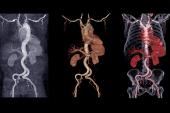AAA-Related Mortality Rates Decline, With Reductions Seen in All Groups
Despite the good news, the decline stalled out in 2015, and understanding why will require some work, says Gregory Piazza.

Despite that positive news, researchers say a noticeable leveling off in recent years is cause for concern.
“In general, there’s a lot to take away from this that’s encouraging, but there are always lessons about how we could do better,” senior investigator Gregory Piazza, MD, MS (Brigham and Women’s Hospital, Boston, MA), told TCTMD. “It was good to see that abdominal aortic aneurysm-related age-adjusted mortality has improved, but there were some plateaus in mortality when we would have expected it to continue to decline. That was primarily in the last 5 years between 2015 and 2020.”
The stalled decline in AAA-attributable mortality was particularly evident in those younger than age 65 and in both Black and white individuals.
The new study, which was published today in the Journal of the American College of Cardiology, spans 1999 to 2020, with data on AAA-attributed mortality extracted from the Centers for Disease Control and Prevention (CDC) WONDER database. Piazza explained they undertook the analysis because of a lack of knowledge about AAA-related mortality, as well as their unproven suspicion that survival is improving as a result of improved screening and access to endovascular repair.
In general, there’s a lot to take away from this that’s encouraging. Gregory Piazza
Over 20 years, there were 269,094 deaths attributed to AAA, a rate of 473.7 deaths per 100,000 people. The average annual percent change (APC) in the age-adjusted mortality rate (AAMR) was -4.0%, down from 5.81 in 1999 to 2.59 per 100,000 individuals in 2020. The APC in deaths attributable to AAA was -4.5% and -3.7% in men and women, respectively. Similar declines were seen in white (-4.0%), Black/African American (-3.6%), Asian/Pacific Islander (-4.4%), and Alaska native/American Indian (-4.6%) populations. The APC in mortality was -4.2% in urban areas compared with -3.5% in rural parts of the country.
In those younger than age 65, the APC was -3.4% versus -4.6% in those age 65 and older. Most of the deaths occurred in the younger patients, and in this group, the AAMR declined until 2009 when it plateaued. In white and Black individuals, the AAA-attributed AAMR plateau occurred around 2015.
“We did see a very nice improvement in AAA-related mortality for those who had rupture,” said Piazza. “I think you can speculate that’s because the endovascular options enable us to get to these patients and repair the rupture so quickly.”
Smoking Down, Hypertension Rates Stable
Using data from NHANES (1999-2020), the researchers examined trends in cardiovascular risk factors associated with AAA mortality, noting that rates of hypertension were relatively stable over the two decades. Obesity rates increased, as did the prevalence of diabetes, but smoking declined as did rates of hyperlipidemia.
“I think this is a very important part of the picture,” said Piazza. “The decline that we've seen in smoking is likely to have played an important role in the trend that we saw for improved AAA-related mortality. We can't prove it in an observational sort of study like this, but it is such a key factor for aneurysm development and progression. I think we can also speculate that in addition to the improvements in risk factors, our screening and treatment may have played a role.”
Like other areas of medicine, Piazza said he’d like this analysis to spur further study into quality-improvement efforts in the care and treatment of patients with AAA. For example, the difference in AAA-attributed mortality in rural versus urban areas may be affected by limited access to medical facilities and advanced treatments, as well as poorer cardiovascular health and variable screening.
“We’re a large country made up of many different communities and decreasing the overall burden of vascular and cardiovascular disease in America means that we have to make sure that all of our communities are benefiting from advances in screening and treatment,” said Piazza. “If we leave some out, that's the kind of situation where we see these plateaus, I think. We won't get as much as we would expect from our investment in innovation because we're not getting that innovation to everyone.”
Michael O’Riordan is the Managing Editor for TCTMD. He completed his undergraduate degrees at Queen’s University in Kingston, ON, and…
Read Full BioSources
Zuin M, Aggarwal R, Bikdeli B, et al. Abdominal aortic aneurysm-attributed mortality in the United States. J Am Coll Cardiol. 2024;Epub ahead of print.
Disclosures
- Piazza reports research grants to his institution from Bristol Myers Squibb/Pfizer, Janssen, Alexion, Bayer, Amgen, BSC, Esperion, and the National Institutes of Health. He reports consulting fees for advisory roles from BSC, Amgen, PERC, NAMSA, Bristol Myers Squibb, Janssen, Penumbra, and Thrombolex.





Comments